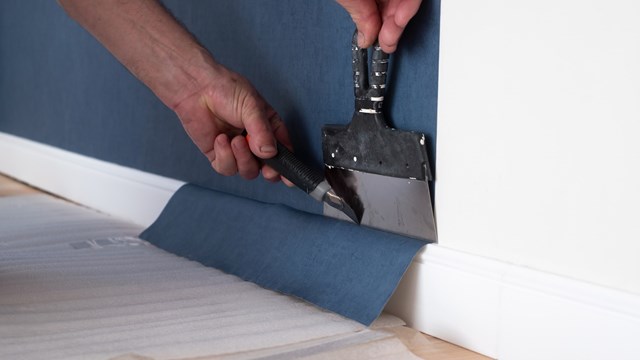
These days, the urge to save a few dollars here and there may be inspiring the creatively inclined to try their hand at home renovation. Before picking up the paint brush or tearing up that carpeting however, it may be worth it to consult a professional designer or architect. With myriad building codes, board rules and the unknown risks that lie within each load-bearing wall or decades-old bundle of wires, the D-I-Y approach can get tricky for even the handiest homeowner.
Starting Out Small
Still, that isn't to say that there aren’t plenty of small things a homeowner can do that will make a big difference to the look and feel of their co-op or condo. Marilyn Sygrove, president of Sygrove Associates Design Group, Inc. in Manhattan says there are a variety of inexpensive yet highly effective options for people who want to freshen up their living space.
First, less can indeed be more. “A good, old-fashioned spring cleaning where you can edit some of your possessions and dispose of damaged or less useful items” can be a good option, Sygrove says. “Simply getting rid of something you have been hanging on to opens up your space. Less clutter and repositioning what you have decided to retain can make a huge difference in the appearance of the size of the apartment. If you can see the floor, the space will look larger.”
Organization can also help in achieve that de-cluttered effect. “Remove things that stick out, like hanging shelves or racks,” Sygrove says. “They cut into your space. A long-term worthwhile investment would be to have your closets outfitted for better storage so you can eliminate wall mounted shelving that eats up space.”
Designer Kim Depole, owner of Kim Depole Design Inc. in Manhattan suggests oversized mirrors as another inexpensive way to shake up a room. “They provide double the lighting effect,” she says. And as an added bonus, “just about everyone likes to look at themselves when they are running out of the building.”
Light is also key, Sygrove says. “Get rid of heavy window treatments and add a few more lamps to give the apartment a lighter feeling,” she suggests.
That sense of light can be achieved through color choices as well. “Keep your floors light in color, which is easily done with a new light-colored rug,” Sygrove says. “Floating furniture on a rug also gives the feeling of space.” Also, “Your furnishings and finishes should be as monochromatic as possible. Get rid of those flashy throw pillows and replace them with colors that match the furniture and walls. And if you are repainting, keep to light, soothing colors that are in the same family as the important pieces of upholstered furniture and window treatments.”
Even the bathroom can benefit from some relatively minor touches. “A see-through shower curtain will make the bathroom look larger,” Sygrove says. “Replace a chunky vanity that goes to the floor with a lighter pedestal-style sink on legs. They still come with built-in storage.”
First Steps
Before replacing that sink, though, it’s important to follow all of the proper steps for larger at-home projects. One of a homeowner’s first calls should be to management.
“It has been our experience that before any work is to be performed, the unit owner must provide the managing agent and board with the information required in the building’s alteration rules and practices,” says Dennis H. Greenstein, a Manhattan-based co-op and condo real estate attorney and partner at Seyfarth Shaw. “Generally the painting of apartments and delivery of cabinetry to be installed does not require the prior approval of the board. However, it is not unusual for the board to still require insurance from any workers and contractors prior to the work commencing.”
Steve Zirinsky, president of Zirinsky Architecture PC in Long Island City, agrees. “Buildings are becoming more and more restrictive these days,” he says. “It’s important to talk to your managing agent to find out what involvement the building wants you to have from outside professionals. You should do this for anything more than painting. Even with painting, though, the building will likely want to know who the contractors are and if they have the correct insurance. People can unintentionally cause themselves trouble.”
One of the safest bets is to simply consult first with the building’s designer or architect before launching into any new projects. The architect knows the building best and can determine if your project will affect any structural aspects of the building or unintentionally wreak havoc with fire safety codes.
Often, a resident will start work on what they think is a small project only to find it has larger repercussions. Zirinsky tells the story of a building architect who was overseeing some exterior renovation work. One afternoon, he heard pounding coming from inside one of the apartments. When he peeked inside the window, he saw the unit owner chipping away at a ledge he later learned the resident did not like. It turned out that the seemingly innocuous ledge was actually a relieving masonry wall. If the unit owner had succeeded in dismantling it, the whole corner of the building—six or seven stories—would have come down. “Of course the owner didn’t know this,” Zirinsky says. “He thought he was just taking out some bricks. But that’s why it’s important to turn to people who have been trained to do this kind of work.”
Alterations and improvements such as moving walls, changing or adding plumbing or electrical lines generally requires that the unit owner sign an alteration agreement with the board, says Greenstein. “The agreement requires plans and specifications to be provided to show all of the work to be performed, which is then reviewed by the building’s architect. It also requires insurance from the contractor and where applicable, filings with the Department of Buildings (DOB), such as a work permit.
Finding the proper tradespeople to carry out the work is key. “One rule that should be written in stone is to hire licensed tradesmen,” says Depole. “Electricians and plumbers should be vetted before starting any work. It only takes one simple phone call to the licensing board.” Checking on past histories also may contribute to getting the best crew possible. “Having a good contractor is essential,” she adds. “I always check at least four references and take the time to see the work with the former clients at hand to confirm the workmanship. Like any other process, you need to do your prep work and take the word ‘assume’ out of your vocabulary.”
Greenstein also suggests that a copy of the building’s alteration policy and application be given to all contractors from whom bids have been requested. This will help them understand what type of insurance is required, the days and hours work may be performed and what restrictions such as prohibitions against the use of jackhammers might exist. “Once the building’s architect comments on the plans and they are finalized and approved by the board, the contractor should finalize the bids. Once one is selected, the work (should start) after coordinating with the building’s superintendent and managing agent.”
Do I Have To?
It can take some time and effort to get all the construction ducks in a row before a renovation or redesign can begin. Some unit owners may be tempted to ignore those initial steps. “If they feel the board is being capricious, people will resist,” says Zirinsky. “Sometimes, though, a board will decided they want or need to tighten some things up and you’re just the wrong person at the wrong time.” He gives the example of a resident who buys a used washer and dryer from another tenant. When it comes time to install that unit in his or her own apartment, the board says no. While that may seem like just a cruel whim to the new owner of the washer and dryer, the board likely made the rule because there may have been issues of leaks or some other mishap with that type or size of machine. “The building doesn’t mean anything by it,” Zirinsky says. It’s just a rule that had to be made.
Taking the time to do things properly will also help with keeping your neighbors happy during those days of buzzing saws and pounding nails. “After years of experience, I follow the good neighbor is a happy neighbor rule,” says Depole. “I always leave a personal note for residences that are in close proximity to the renovation. Then after we complete the job, I leave a thank you note and flowers or something sweet. Often my clients throw an open house party to show off their new digs.” That is an ideal way to show patient neighbors that the slight fuss and muss was worth the aesthetic effort.
Staying on top of the work can also help eliminate frustration from neighbors. The design professional should ensure that all contractors are in compliance with all of the building’s rules and regulations with regard to hours of work, protection of common areas and other facets of the job that might impact other residents. “Design professionals should visit the site weekly or on an ‘as-needed’ basis to monitor the workers and assure that all is going smoothly.
Most importantly, if the proper rules and regulations for the building and the city are not followed, the penalties can be stiff. “The number one question every designer is asked is, do I have to file with the city?” Zirinsky says. The answer is an emphatic yes. For one thing, there may be new codes that the homeowner or even the designer may not know about, like a new energy code introduced into the city in December 2010 that requires compliance whether the property owner files or not—basically, you need to know about it even if you don’t know about it. These are the kinds of things that a little preventative footwork can eliminate.
The building’s boards also can enforce strict penalties for non-compliance. “The board in its discretion can likely force the unit owner to restore the apartment to its prior condition,” Greenstein says. “Fines may be imposed as well. In any event, most boards will demand that the work cease until the board makes a decision as to whether or not it will require restoration or alternatively, allow the unit owner to continue work but with more stringent requirements.”
Once all of the legwork is complete, undertaking a new design or renovation project can help transform your family’s living space and breathe new life into your home. If it can make the old feel new again, then all the preparation and work will be worth it, not to mention the satisfaction of having a beautiful space to call home.
Liz Lent is a freelance writer and a frequent contributor to The Cooperator.






Leave a Comment